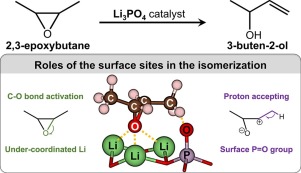Molecular Catalysis ( IF 3.9 ) Pub Date : 2017-12-01 , DOI: 10.1016/j.mcat.2017.11.018 Tae Yong Kim , Chyan Kyung Song , Yang Sik Yun , Danim Yun , Jeong Woo Han , Jongheop Yi

|
Basic lithium phosphate (B-LPO) catalyst selectively produces unsaturated alcohols from epoxides. The catalytic activity of B-LPO is known to originate from appropriate acidic-basic properties, but no details were available on the structure of the active site. In this study, experimental methods and DFT calculations were performed in an attempt to identify the active surface structure of B-LPO for the isomerization of 2,3-epoxybutane to 3-buten-2-ol. The experimental results showed that exchanged Na ions in B-LPO suppressed the formation of an acid-catalyzed by-product (methyl ethyl ketone). In addition, H2O had a negative effect on the formation of 3-buten-2-ol due to the preoccupation of the active site. DFT calculations in conjunction with these experimental observations showed that the most plausible active surface for the formation of 3-buten-2-ol is the (001) surface of LPO whose acidic proton is exchanged with Na atom. On this surface, the under-coordinated Li atoms and the surface PO groups are exposed, and these play a role in activating the C
O bond of an epoxide ring, and in receiving a proton from the terminal carbon, respectively.
中文翻译:

磷酸锂催化剂用于2,3-环氧丁烷异构化为3-buten-2-ol的活性位点结构
碱性磷酸锂(B-LPO)催化剂可从环氧化物选择性生产不饱和醇。已知B-LPO的催化活性源于适当的酸性-碱性性质,但是没有关于活性位点结构的详细信息。在这项研究中,进行实验方法和DFT计算,以试图确定B-LPO的活性表面结构,以将2,3-环氧丁烷异构化为3-buten-2-ol。实验结果表明,B-LPO中交换的Na离子抑制了酸催化副产物(甲乙酮)的形成。另外,H 2由于对活性位点的过度关注,O对3-丁烯-2-醇的形成具有负面影响。DFT计算结合这些实验观察结果表明,形成3-丁烯-2-醇最合理的活性表面是LPO的(001)表面,其酸性质子与Na原子交换。在该表面上,配位不足的Li原子和表面的P O基团被暴露,它们分别在活化
环氧化物的C O键和从末端碳接受质子方面发挥作用。











































 京公网安备 11010802027423号
京公网安备 11010802027423号